Using the National Incident-Based Reporting System (NIBRS) to Study Animal Cruelty: Preliminary Results (2016–2019)
Abstract
:1. Introduction
2. Background
2.1. Why Study Animal Cruelty?
2.2. History of Crime Data Collection in the United States
2.3. National Incident-Based Reporting System (NIBRS)
2.4. Incorporation of Animal Cruelty into the NIBRS
3. Results: NIBRS Animal Cruelty Data (2019)
3.1. Animal Cruelty Reporting: Year to Year Variations
3.2. Animal Cruelty Reporting: A State-by-State Comparison of Co-Occurring Crime Data
3.3. Characteristics of the Animal Cruelty Incidents and Offenders
3.3.1. Spatiotemporal Variation of Animal Cruelty Incidents
3.3.2. Gender of Animal Cruelty Offenders
3.3.3. Age of Animal Cruelty Offenders
3.4. Incident-Specific Crime Details
3.4.1. Gender vs. Type of Animal Cruelty
3.4.2. Time of Day of Incidents vs. Age and Type of Animal Cruelty
3.5. Co-Occurring Crimes and Animal Cruelty
4. Discussion
4.1. Intentional Animal Cruelty and Human Sexual Assault
4.2. Child Maltreatment and Animal Cruelty
5. Conclusions and Future Work
Funding
Institutional Review Board Statement
Informed Consent Statement
Data Availability Statement
Acknowledgments
Conflicts of Interest
References
- Addington, Lynn A. 2009. Studying the crime problem with NIBRS data: Current uses and future trends. In Handbook on Crime and Deviance. Edited by Marv D. Krolm, Alan J. Lizotte and Gina P. Hall. New York: Springer. [Google Scholar] [CrossRef]
- Addington, Lynn A. 2015. Research adventures with "kinda big" data: Using NIBRS to study crime. In Envisioning Criminology: A Handbook of Emerging Research Strategies for Studying Crime and Justice. Edited by M. D. Maltz and S. K. Rice. New York: Springer, pp. 157–63. [Google Scholar] [CrossRef]
- Addington, Lynn A., and Mary Lou Randour. 2012. Animal Cruelty Crime Statistics: Findings from a Survey of State Uniform Crime Reporting Programs. Washington, DC: Animal Welfare Institute. [Google Scholar]
- American Pet Products Association. 2020. Pet Industry Market Size and Ownership Statistics. Available online: https://www.americanpetproducts.org/press_industrytrends.asp (accessed on 15 June 2021).
- Arkow, Phil, and Randall Lockwood. 2016. Definition of animal cruelty, abuse, and neglect. In Animal Cruelty: A Multidisciplinary Approach to Understanding, 2nd ed. Edited by Mary P. Brewster and Cassandra L. Reyes. Durham: Carolina Academic Press, pp. 3–23. [Google Scholar]
- Arluke, Arnold, and Randall Lockwood. 1997. Guest editor’s introduction: Understanding cruelty to animals. Society and Animals 5: 183–93. [Google Scholar]
- Arluke, Arnold, Jack Levin, Carter Luke, and Frank Ascione. 1999. The relationship of animal abuse to violence, and other forms of antisocial behavior. Journal of Interpersonal Violence 14: 963–75. [Google Scholar] [CrossRef]
- Ascione, Frank R. 1999. The abuse of animals and human interpersonal violence: Making the connection. In Child Abuse, Domestic Violence, and Animal Abuse: Linking the Circles of Compassion for Prevention and Intervention. Edited by Frank R. Ascione and Phil Arkow. West Lafayette: Purdue University Press, pp. 50–61. [Google Scholar]
- Ascione, Frank R. 2001. Animal abuse and youth violence. Juvenile Justice Bulletin. Available online: https://www.ncjrs.gov/pdffiles1/ojjdp/188677.pdf (accessed on 7 February 2021).
- Ascione, Frank R., and Kenneth Shapiro. 2009. People and animals, kindness and cruelty: Research directions, and policy implications. Journal of Social Issues 65: 569–87. [Google Scholar] [CrossRef] [Green Version]
- Ascione, Frank R., Shelby E. McDonald, Philip Tedeschi, and James Williams. 2018. The relations among animal abuse, psychological disorders, and crime: Implications for forensic assessment. Behavioral Sciences and the Law. [Google Scholar] [CrossRef]
- Baldry, Anna C. 2005. Animal abuse among preadolescents directly and indirectly victimized at school and at home. Criminal Behaviour and Mental Health 15: 97–110. [Google Scholar] [CrossRef] [PubMed]
- Bernays, Kayla A. 2018. We’ve still got feelings: Re-presenting pets as sentient property. Arizona Law Review 60: 485–508. Available online: https://arizonalawreview.org/pdf/60-2/60arizlrev485.pdf (accessed on 29 July 2021).
- Bibel, Daniel. 2015. Considerations and Cautions Regarding NIBRS Data: A View from the Field. Justice Research and Policy 16: 185–94. [Google Scholar] [CrossRef]
- Bir, Courtney, Candace C. Croney, and Nicole J. O. Widmar. 2018. U.S. residents’ perceptions of dog welfare needs and canine welfare information sources. Journal of Applied Animal Welfare Science 22: 42–68. [Google Scholar] [CrossRef]
- Brewster, Mary P., and Shannon T. Grugan. 2016. Emerging issues and future directions in the area of animal cruelty. In Animal Cruelty: A Multidisciplinary Approach to Understanding, 2nd ed. Edited by Mary P. Brewster and Cassandra Reyes. Durham: Carolina Academic Press, pp. 397–423. [Google Scholar]
- Bright, Melissa A., Mona Sayedul Huq, Terry Spencer, Jennifer W. Applebaum, and Nancy Hardt. 2018. Animal cruelty as an indicator of family trauma: Using adverse childhood experiences to look beyond child abuse and domestic violence. Child Abuse and Neglect 76: 287–96. [Google Scholar] [CrossRef]
- Bureau of Justice Statistics. n.d. About the Uniform Crime Reporting Program. The Nation’s Two Crime Measures. Available online: https://www.bjs.gov/ucrdata/abouttheucr.cfm; https://www.bjs.gov/ucrdata/twomeasures.cfm. (accessed on 29 July 2021).
- Campbell, Andrew M. 2020. An increasing risk of family violence during the Covid-19 pandemic: Strengthening community collaborations to save lives. Forensic Science International: Reports 2: 100089. [Google Scholar] [CrossRef]
- Campbell, Andrew M., Ralph A. Hicks, Shannon L. Thompson, and Sarah E. Wiehe. 2017. Characteristics of intimate partner violence incidents and the environments in which they occur: Victim reports to responding law enforcement officers. Journal of Interpersonal Violence, 0886260517704230. [Google Scholar] [CrossRef]
- Campbell, Andrew M., Shannon L. Thompson, Tara L. Harris, and Sarah E. Wiehe. 2021. Intimate Partner Violence and Pet Abuse: Responding Law Enforcement Officers’ Observations and Victim Reports from the Scene. Journal of Interpersonal Violence 36: 2353–72. [Google Scholar] [CrossRef] [PubMed]
- Catalano, Shannan. 2015. Intimate Partner Violence, 1993–2010. Available online: https://bjs.ojp.gov/content/pub/pdf/ipv9310.pdf (accessed on 7 July 2021).
- Centers for Disease Control and Prevention. 2020a. Preventing Intimate Partner Violence. Available online: https://www.cdc.gov/violenceprevention/intimatepartnerviolence/fastfact.html (accessed on 29 June 2021).
- Centers for Disease Control and Prevention. 2020b. Evidence for Limited Early Spread of COVID-19 within the United States, January–February 2020. Available online: https://www.cdc.gov/mmwr/volumes/69/wr/mm6922e1.htm (accessed on 4 July 2021).
- Dedel, Kelly. 2012. Animal Cruelty: Problem-Oriented Guide for Police. Problem-Specific Guide Series No. 65. Available online: https://popcenter.asu.edu/content/animal-cruelty-0 (accessed on 18 July 2021).
- DeGue, Sarah, and David DiLillo. 2009. Is Animal Cruelty a “Red Flag” for Family Violence?: Investigating Co-Occurring Violence Toward Children, Partners, and Pets. Journal of Interpersonal Violence 24: 1036–56. [Google Scholar] [CrossRef]
- Eisenstein, Yolanda. 2016. Animal cruelty and the law: Prohibited conduct. In Animal Cruelty: A Multidisciplinary Approach to Understanding, 2nd ed. Edited by Mary P. Brewster and Cassandra Reyes. Durham: Carolina Academic Press, pp. 47–63. [Google Scholar]
- Favre, David. 2016. The history of anti-cruelty laws: Concepts of animal welfare and animal rights. In Animal Cruelty: A Multidisciplinary Approach to Understanding, 2nd ed. Edited by Mary P. Brewster and Cassandra Reyes. Durham: Carolina Academic Press, pp. 25–45. [Google Scholar]
- Favre, David. 2017. Animals as living property. In The Oxford Handbook of Animal Studies. Oxford: Oxford University Press, pp. 65–80. [Google Scholar]
- Federal Bureau of Investigation. 2015. Multi-Agency Letter in Support of the NIBRS Transition. Available online: https://www.fbi.gov/file-repository/ucr/nibrs-joint-seal-letter-of-support-august-2015.pdf/view (accessed on 7 July 2021).
- Federal Bureau of Investigation. 2016. Tracking Animal Cruelty: FBI Collecting Data on Crimes Against Animals. Available online: https://www.fbi.gov/news/stories/-tracking-animal-cruelty (accessed on 7 April 2019).
- Federal Bureau of Investigation. 2018a. 30 Questions and Answers about NIBRS Transition. Available online: https://www.fbi.gov/file-repository/ucr/30-faqs-about-nibrs-transition-oct-2018.pdf/view (accessed on 7 July 2021).
- Federal Bureau of Investigation. 2018b. FBI Letter on NIBRS Transition. Available online: https://www.fbi.gov/file-repository/ucr/fbi-letter-on-nibrs-transition-071018.pdf/view (accessed on 7 July 2021).
- Federal Bureau of Investigation. 2019a. Countdown to NIBRS. Available online: https://www.fbi.gov/file-repository/ucr/nibrs-countdown-flyer.pdf/view (accessed on 7 April 2019).
- Federal Bureau of Investigation. 2019b. National Incident Based Reporting System Users’ Manual. Available online: https://ucr.fbi.gov/nibrs/nibrs-user-manual/view (accessed on 3 July 2021).
- Federal Bureau of Investigation. 2019c. 2018 NIBRS Crime Data Released. Available online: https://www.fbi.gov/news/stories/2018-nibrs-crime-data-released-120919 (accessed on 3 July 2021).
- Federal Bureau of Investigation. 2019d. FBI Releases 2019 Crime Statistics. Available online: https://ucr.fbi.gov/crime-in-the-u.s/2019/crime-in-the-u.s.-2019/topic-pages/cius-summary (accessed on 8 August 2021).
- Federal Bureau of Investigation. 2020. FBI Releases 2019 Crime Statistics. Available online: https://www.fbi.gov/news/pressrel/press-releases/fbi-releases-2019-crime-statistics (accessed on 29 June 2021).
- Federal Bureau of Investigations. n.d.a. National Incident-Based Reporting System (NIBRS). Available online: https://www.fbi.gov/services/cjis/ucr/nibrs (accessed on 7 July 2021).
- Federal Bureau of Investigation. n.d.b. Crime Data Explorer (CDE). Available online: https://crime-data-explorer.fr.cloud.gov/pages/home (accessed on 29 June 2021).
- Felthous, Alan R., and Stephen R. Kellert. 1987. Childhood cruelty to animals and later aggression against people: A review. American Journal of Psychiatry 144: 270–76. [Google Scholar] [CrossRef]
- Finkelhor, David, and Richard Ormrod. 2000. Characteristics of Crimes Against Juveniles. In Office of Juvenile Justice and Delinquency Prevention. Available online: https://www.ojp.gov/pdffiles1/ojjdp/179034.pdf (accessed on 20 September 2021).
- Fitzgerald, Amy J., Rochelle Stevenson, and Antonio R. Verbora. 2016. Examining Animal Abuse through a Sociological Lens: Theoretical and Empirical Developments. In Animal Cruelty: A Multidisciplinary Approach to Understanding, 2nd ed. Edited by Mary P. Brewster and Cassandra Reyes. Durham: Carolina Academic Press, pp. 325–54. [Google Scholar]
- Flynn, Clif P. 2000. Woman’s best friend: Pet abuse and the role of companion animals in the lives of battered women. Violence against Women 6: 162–77. Available online: https://www.academia.edu/4964538/Womans_Best_Friend_Pet_Abuse_and_the_Role_of_Companion_Animals_in_the_Lives_of_Battered_Women?auto=citations&from=cover_page (accessed on 29 July 2021). [CrossRef]
- Flynn, Clif P. 2011. Examining the links between animal abuse and human violence. Crime, Law, and Social Change 55: 453–68. [Google Scholar] [CrossRef]
- Flynn, Clif P. 2012. Understanding Animal Abuse: A Sociological Analysis. Brooklyn: Lantern Books, 96p. [Google Scholar]
- Fox, Rebekah, and Nancy R. Gee. 2017. Great expectations: Changing social, spatial and emotional understandings of the companion animal–human relationship. Social and Cultural Geography 20: 43–63. [Google Scholar] [CrossRef]
- Gullone, Eleonora, and Nerida Robertson. 2008. The relationship between bullying and animal abuse in adolescents: The importance of witnessing animal abuse. Journal of Applied Developmental Psychology 29: 371–79. [Google Scholar] [CrossRef]
- Gullone, Eleonora. 2016. Family Violence and Animal Cruelty. In Animal Cruelty: A Multidisciplinary Approach to Understanding, 2nd ed. Edited by Mary P. Brewster and Cassandra Reyes. Durham: Carolina Academic Press, pp. 275–300. [Google Scholar]
- Hackett, Simon, and Emma Uprichard. 2007. Animal Abuse and Child Maltreatment: A Review of the Literature and Findings from a UK Study. London: National Society for the Prevention of Cruelty to Children. Available online: https://nationallinkcoalition.org/wp-content/uploads/2013/01/NSPCC-Review.pdf (accessed on 23 July 2021).
- Heide, Kathleen M., and Alan R. Felthous. 2018. Animal maltreatment from ancient times to the 21st century: Foundation for a call to action now. Behavioral Sciences and the Law 36: 657–60. [Google Scholar] [CrossRef] [Green Version]
- Henry, Bill C. 2004. The Relationship between Animal Cruelty, Delinquency, and Attitudes toward the Treatment of Animals. Society and Animals 12: 185–207. [Google Scholar] [CrossRef] [Green Version]
- Hensley, Christopher, Suzanne E. Tallichet, and Erik L. Dutkiewicz. 2009. Recurrent Childhood Animal Cruelty: Is There a Relationship to Adult Recurrent Interpersonal Violence? Criminal Justice Review 34: 248–57. [Google Scholar] [CrossRef]
- Herzog, Hal A. 2007. Gender Differences in Human–Animal Interactions: A Review. Anthrozoös 20: 7–21. [Google Scholar] [CrossRef] [Green Version]
- Hoffer, Tia, Holly Hargreaves-Cormany, Yvonne Muirhead, and J. Reid Meloy. 2018. Violence in Animal Cruelty Offenders. Cham: Springer. [Google Scholar] [CrossRef]
- Hoffman, Christy L., Kaylee Stutz, and Terrie Vasilopoulos. 2018. An examination of adult women’s sleep quality and sleep routines in relation to pet ownership and bedsharing. Anthrozoös 31: 711–25. [Google Scholar] [CrossRef]
- Jarvis, John P. 2015. Examining National Incident-Based Reporting System (NIBRS) Data: Perspectives from a Quarter Century of Analysis Efforts. Justice Research and Policy 16: 195–210. [Google Scholar] [CrossRef]
- Johnson, Scott A. 2018. Animal cruelty, pet abuse and violence: The missed dangerous connection. Forensic Research and Criminology International Journal 6: 403–15. [Google Scholar] [CrossRef]
- Justice Research and Statistics Association. n.d.a Incident-Based Reporting Resource Center, State Profiles: NIBRS Coverage. Available online: http://incidentbased.org/htm/stateprofiles.htm (accessed on 29 June 2021).
- Justice Research and Statistics Association. n.d.b Available online: https://www.jrsa.org (accessed on 8 July 2021).
- LeCates, Rich. 2018. Intelligence-Led Policing: Changing the Face of Crime Prevention. Police Chief. October 17. Available online: https://www.policechiefmagazine.org/changing-the-face-crime-prevention/?ref=4f1d967f817ac811b21c97eea171a4d4 (accessed on 1 July 2021).
- Levitt, Lacey, Tia A. Hoffer, and Ann B. Loper. 2016. Criminal histories of a subsample of animal cruelty offenders. Aggression and Violent Behavior 30: 48–58. [Google Scholar] [CrossRef]
- Levitt, Lacey. 2016. Animal maltreatment: Implications for behavioral science professionals. Behavioral Sciences and the Law 36: 766–85. [Google Scholar] [CrossRef]
- Liao, Dan, Marcus Berzofsky, David Heller, Kelle Barrick, and Matthew DeMichele. 2015. Treatment of missing data in the FBI’s National Incident Based Reporting System: A case study of the Bakken Region, 1970–1981. Paper presented at 2015 Joint Statistical Meetings, Seattle, WA, USA, August 8–13; Available online: http://www.asasrms.org/Proceedings/y2015/files/234045.pdf (accessed on 29 July 2021).
- Lockwood, Randall. 2018. Animal hoarding: The challenge for mental health, law enforcement, and animal welfare professionals. Behavioral Sciences and the Law 36: 698–716. [Google Scholar] [CrossRef]
- McEwen, Fiona S., Terrie E. Moffitt, and Louise Arseneault. 2014. Is childhood cruelty to animals a marker for physical maltreatment in a prospective cohort study of children? Child Abuse and Neglect 38: 533–43. [Google Scholar] [CrossRef] [PubMed] [Green Version]
- Meloy, J. Reid. 2006. Empirical basis and forensic application of affective and predatory violence. Australian and New Zealand Journal of Psychiatry 40: 539–47. [Google Scholar] [CrossRef]
- Monsalve, Stefany, Fernando Ferreira, and Rita Garcia. 2017. The connection between animal abuse and interpersonal violence: A review from the veterinary perspective. Research in Veterinary Science 114: 18–26. [Google Scholar] [CrossRef]
- National Academy of Sciences, Engineering, and Medicine. 2016. Modernizing Crime Statistics—Report 1: Defining and Classifying Crime. Washington, DC: The National Academies Press. [Google Scholar] [CrossRef]
- National Academy of Sciences, Engineering, and Medicine. 2018. Modernizing Crime Statistics—Report 2: New Systems for Measuring Crime. Washington, DC: The National Academies Press. [Google Scholar] [CrossRef]
- National Archive of Criminal Justice Data. n.d. National Incident Based Reporting System Series. Available online: https://www.icpsr.umich.edu/web/NACJD/series/128 (accessed on 29 June 2021).
- National Children’s Advocacy Center. 2019. Animal Abuse Co-Occurring with Child Maltreatment: A Bibliography. Available online: https://calio.org/wp-content/uploads/2020/05/animal-abuse-co-occurring-bib.pdf (accessed on 23 July 2021).
- National Crime Statistics Exchange Initiative. n.d. National Incident-Based Reporting System and National Crime Statistics Exchange (NCS-X) Initiative. Available online: https://bjs.ojp.gov/programs/national-crime-statistics-exchange (accessed on 29 July 2021).
- Office for Victims of Crime. n.d. National Incident-Based Reporting System: Using NIBRS Data to Understand Victimization. Available online: https://ovc.ojp.gov/sites/g/files/xyckuh226/files/pubs/NIBRS/pfv.html (accessed on 6 July 2021).
- Palais, Julie. 2019. Utilizing the National Incident-Based Reporting System (NIBRS) to Study Animal Cruelty: Preliminary Results and Opportunities for Future Research. Unpublished Capstone Research Paper. Buffalo: Canisius College. [Google Scholar]
- Palais, Julie M. 2020a. Animal Cruelty Hurts People Too: How Animal Cruelty Crime Data Can Help Police Make Their Communities Safer for All. Police Chief Magazine. pp. 42–48. Available online: https://www.policechiefmagazine.org/animal-cruelty-hurts-people-too/ (accessed on 29 July 2021).
- Palais, Julie. 2020b. Crunching the Numbers on Cruelty: The National Incident-Based Reporting System Delivers Preliminary Data on Animal Cruelty Investigations. Sheriff and Deputy Magazine, 70–73. Available online: http://www.ourdigitalmags.com/publication/?m=11768&i=672270&view=articleBrowser&article_id=3756408 (accessed on 29 July 2021).
- Palais, Julie. 2020c. Animal Cruelty in the U.S.: What you should know and how you can help. Animal Care and Control Today. pp. 19–23. Available online: https://www.nacanet.org/animal-care-control-today-magazine/ (accessed on 29 July 2021).
- Palais, Julie. 2020d. The Link between Animal Cruelty and Public Safety: Defining the Role of the Animal Control Officer. Public Management. August 1, pp. 16–21. Available online: https://icma.org/articles/pm-magazine/link-between-animal-cruelty-and-public-safety (accessed on 29 July 2021).
- Patronek, Gary J. 1997. Issues for Veterinarians in Recognizing and Reporting Animal Neglect and Abuse. Society and Animals 5: 267–80. [Google Scholar] [CrossRef] [Green Version]
- Poggio, Eugene C., Stephen D. Kennedy, Jan M. Chaiken, and Kenneth E. Carlson. 1985. Blueprint for the Future of the Uniform Crime Reporting Program; Rockville: U.S. Department of Justice, Bureau of Justice Statistics, Federal Bureau of Investigation, Abt Associates, p. 341. Available online: https://www.ojp.gov/ncjrs/virtual-library/abstracts/blueprint-future-uniform-crime-reporting-program-final-report-ucr (accessed on 29 July 2021).
- Randour, Mary Lou, and Maya Gupta. 2016. Psychological theories of animal cruelty. In Animal Cruelty: A Multidisciplinary Approach to Understanding, 2nd ed. Edited by Mary P. Brewster and Cassandra Reyes. Durham: Carolina Academic Press, pp. 355–75. [Google Scholar]
- Randour, Mary Lou, Martha Smith-Blackmore, Nancy Blaney, Dan DeSousa, and Audrey A. Guyony. 2021. Animal Abuse as a Type of Trauma: Lessons for Human and Animal Service Professionals. Trauma Violence Abuse 2: 277–88. [Google Scholar] [CrossRef]
- Randour, Mary Lou. 2019. NIBRS needs both law enforcement and animal control officers. The “Link” and Law Enforcement: Crimes against Animals are Crimes Against People: Sheriff and Deputy: Special Issue. pp. 12–13. Available online: https://www.sheriffs.org/sites/default/files/2019_SD_AA.pdf (accessed on 29 July 2021).
- Randour, Mary Lou. n.d. Including animal cruelty as a factor in assessing risk and designing interventions. Persistently Safe Schools: The National Conference of the Hamilton Fish Institute on School and Community Violence. pp. 103–10. Available online: https://pdfs.semanticscholar.org/c101/5692a3f884979346cc8ae11fb68f485d88d4.pdf (accessed on 7 July 2021).
- Reyes, Cassandra L. 2016. Statistics and measurement of animal cruelty. In Animal Cruelty: A Multidisciplinary Approach to Understanding, 2nd ed. Edited by Mary P. Brewster and Cassandra Reyes. Durham: Carolina Academic Press, pp. 141–56. [Google Scholar]
- Rowan, Andrew, and Tamara Kartal. 2018. Dog Population and Dog Sheltering Trends in the United States of America. Animals 8: 68. [Google Scholar] [CrossRef] [Green Version]
- Schaffner, Joan E. 2011. An Introduction to Animals and the Law. London: Palgrave Macmillan. [Google Scholar] [CrossRef]
- Smith, Erica, Kimberly Martin, Kelle Barrick, and Nick Richardson. 2018. Leveraging NIBRS to better understand sexual violence. Police Chief. May. Available online: https://www.policechiefmagazine.org/rib-leveraging-nibrs-sexual-violence/?ref=7430fa6083fd228a6e33ef329bada578 (accessed on 18 July 2021).
- Snyder, Howard L. 2013a. National Crime Statistics Exchange (NCS-X): Building on NIBRS for More Accurate National Crime Estimates. Available online: http://www.jrsa.org/pubs/forum/jun2013_31-2/ncsx-print.htm (accessed on 29 July 2021).
- Snyder, Howard L. 2013b. NCS-X: Building a system of national crime statistics for the 21st century. The Criminologist 38: 19–21. Available online: https://www.bjs.gov/content/pub/pdf/ncsx_system_snyder.pdf (accessed on 29 July 2021).
- Tallichet, Suzanne E., and Christopher Hensley. 2004. Exploring the Link between Recurrent Acts of Childhood and Adolescent Animal Cruelty and Subsequent Violent Crime. Criminal Justice Review 29: 304–16. [Google Scholar] [CrossRef]
- Targonski, Joseph R. 2011. A Comparison of Imputation Methodologies in the Offenses-Known Uniform Crime Reports; Final Report. Washington: U.S. Department of Justice. Available online: https://www.ncjrs.gov/pdffiles1/nij/grants/235152.pdf (accessed on 16 July 2021).
- Taylor, Nik, and Tania Signal. 2016. Animal Cruelty and Delinquency, Criminality, and Youth Violence. In Animal Cruelty: A Multidisciplinary Approach to Understanding, 2nd ed. Edited by Mary P. Brewster and Cassandra Reyes. Durham: Carolina Academic Press, pp. 253–73. [Google Scholar]
- U.S. Census Bureau. 2019. U.S. Census Bureau Quick Facts. Available online: https://www.census.gov/quickfacts/fact/table/US/PST045219 (accessed on 2 July 2021).
- U.S. Department of Health and Human Services. 2019. Child Maltreatment. Available online: https://www.acf.hhs.gov/cb/data-research/child-maltreatment (accessed on 30 June 2021).
- Vaughn, Michael G., Qiang Fu, Matt DeLisi, Kevin M. Beaver, Brian E. Perron, Katie Terrell, and Matthew O. Howard. 2009. Correlates of cruelty to animals in the United States: Results from the National Epidemiologic Survey on Alcohol and Related Conditions. Journal of Psychiatric Research 43: 1213–18. [Google Scholar] [CrossRef] [Green Version]
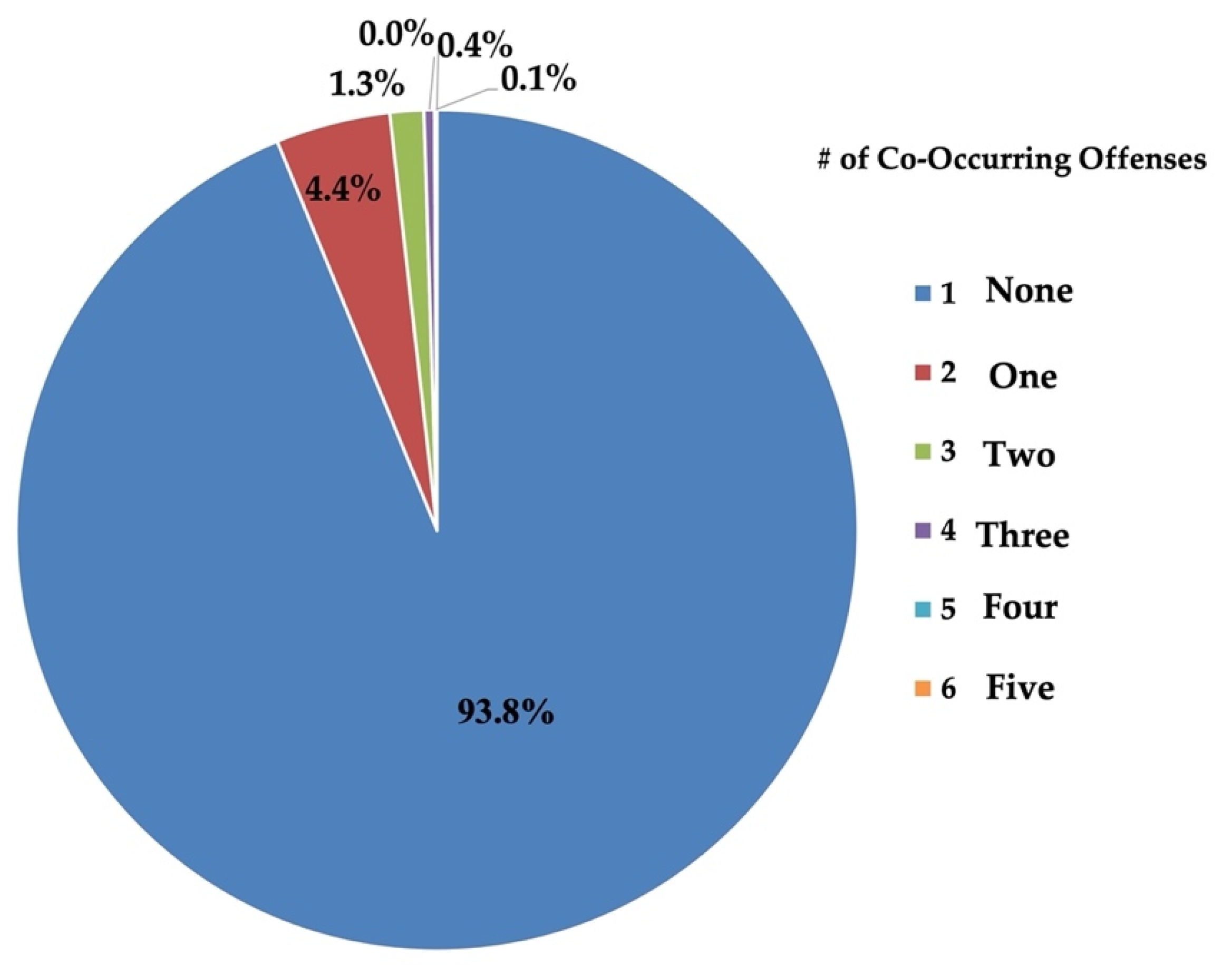
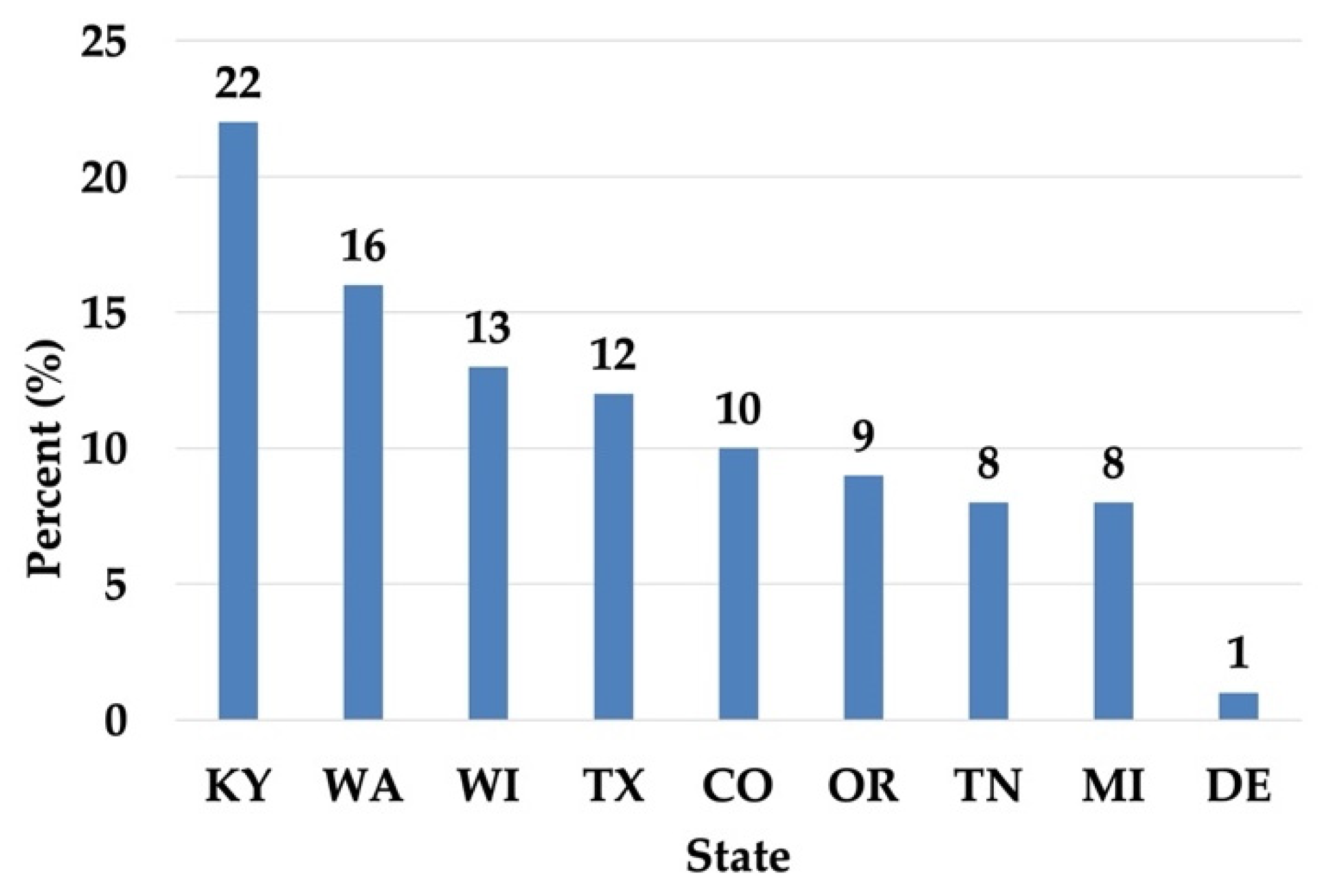
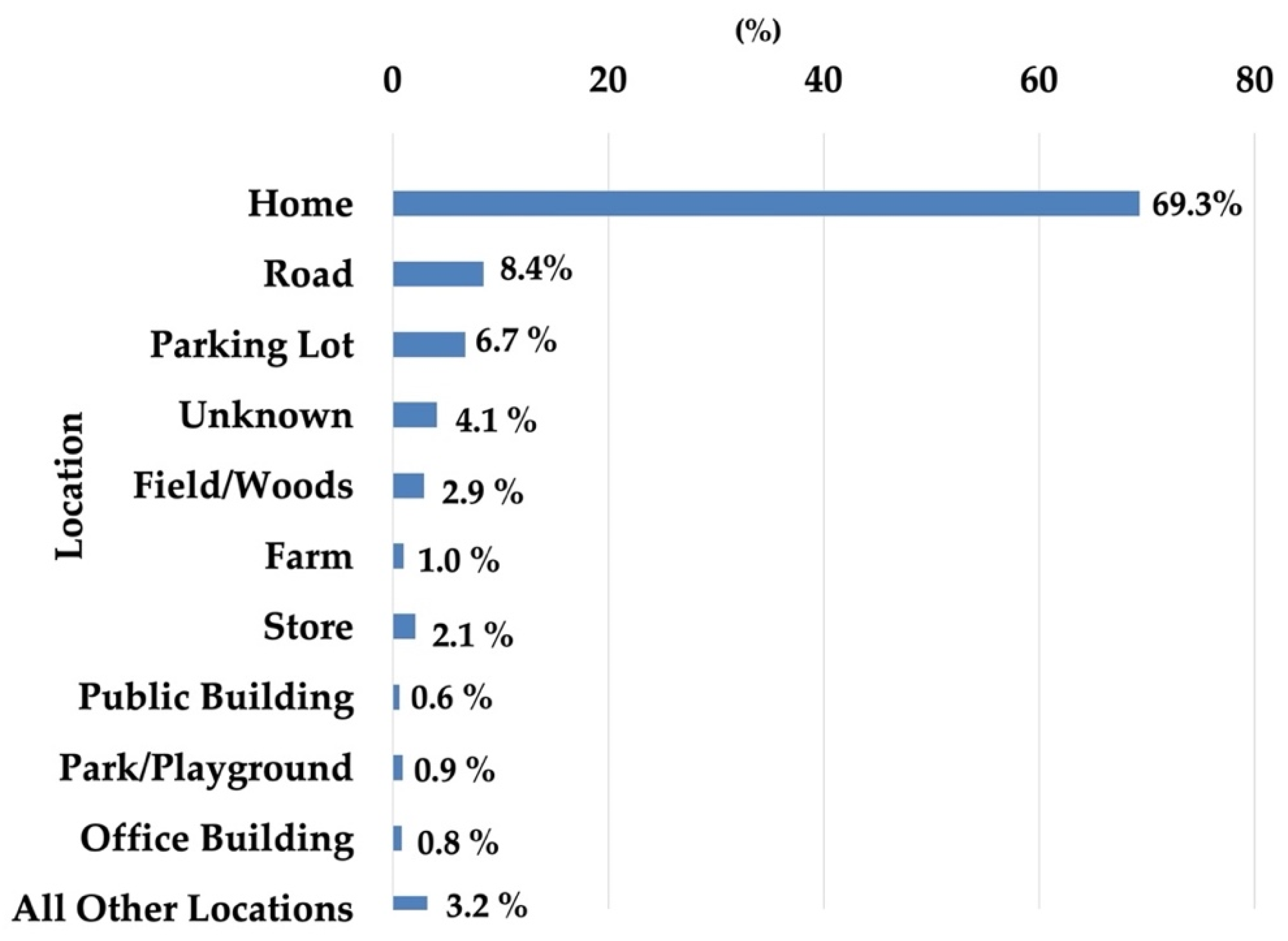

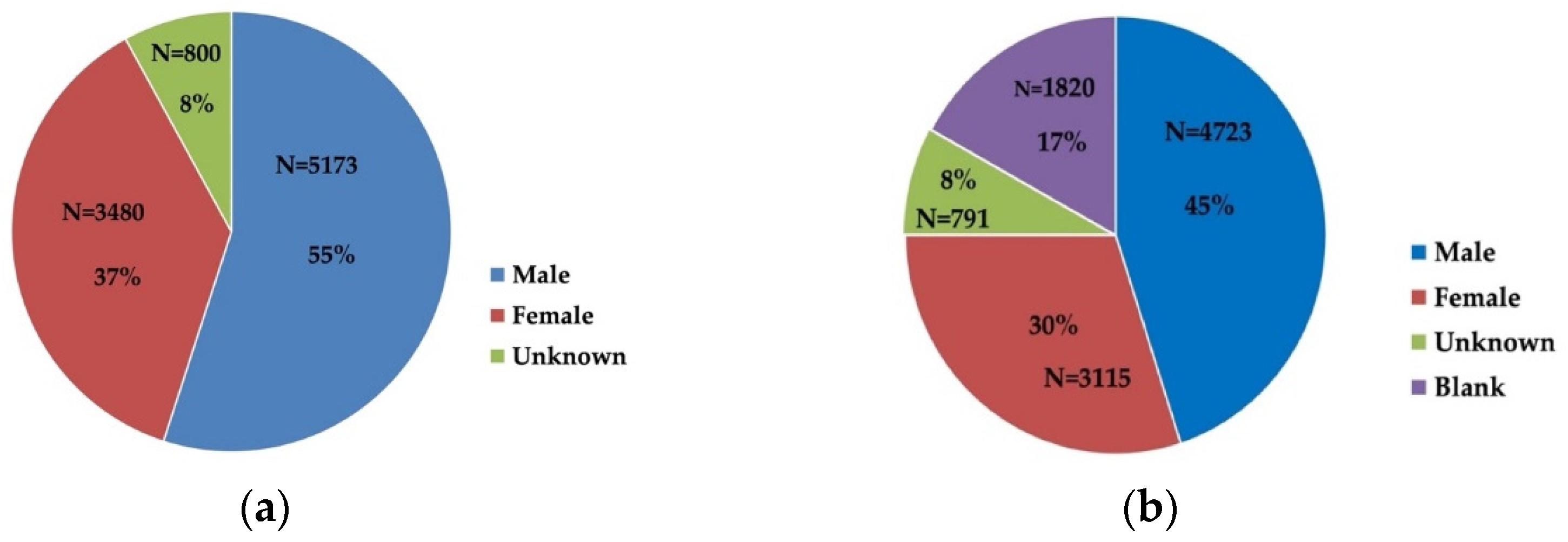


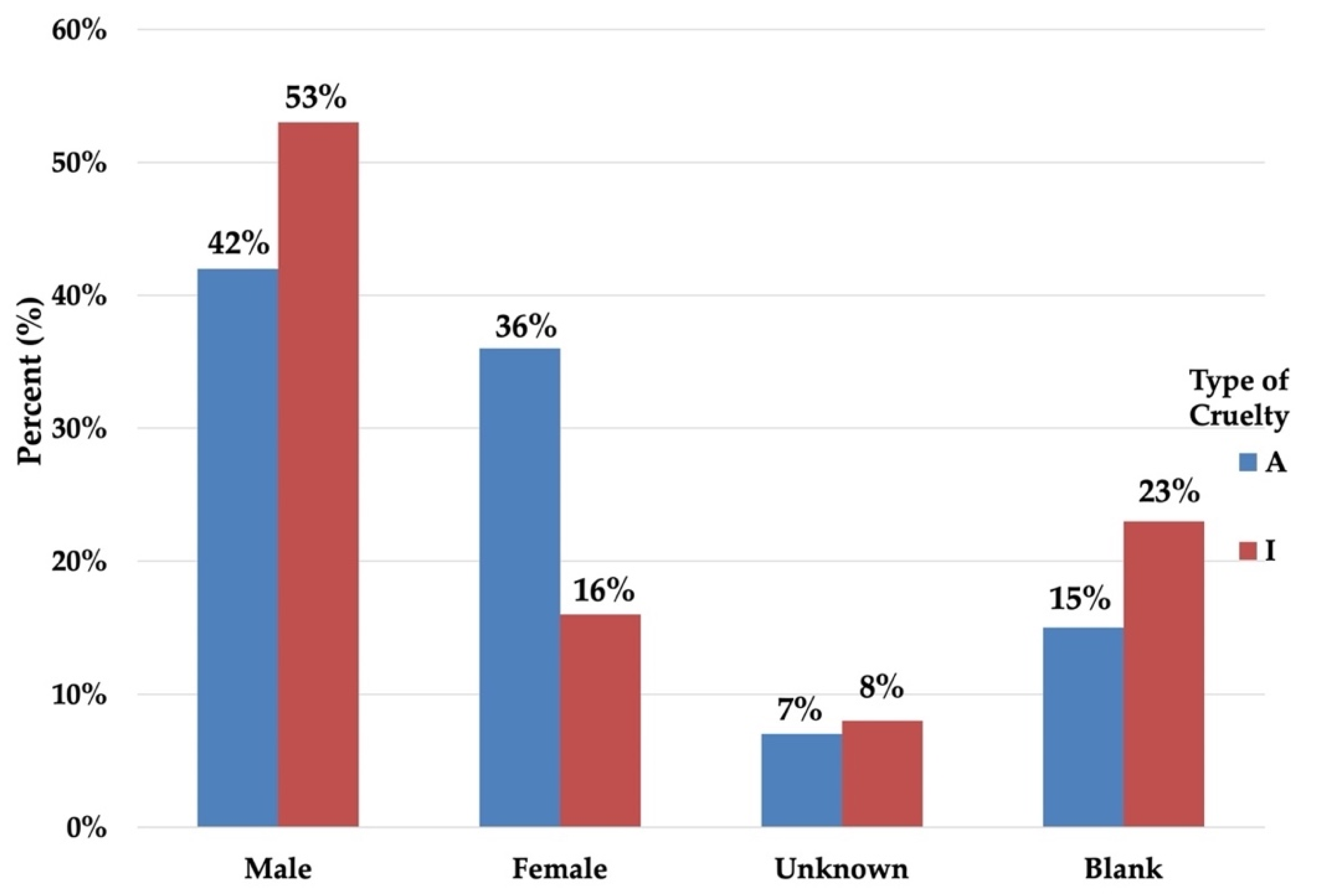
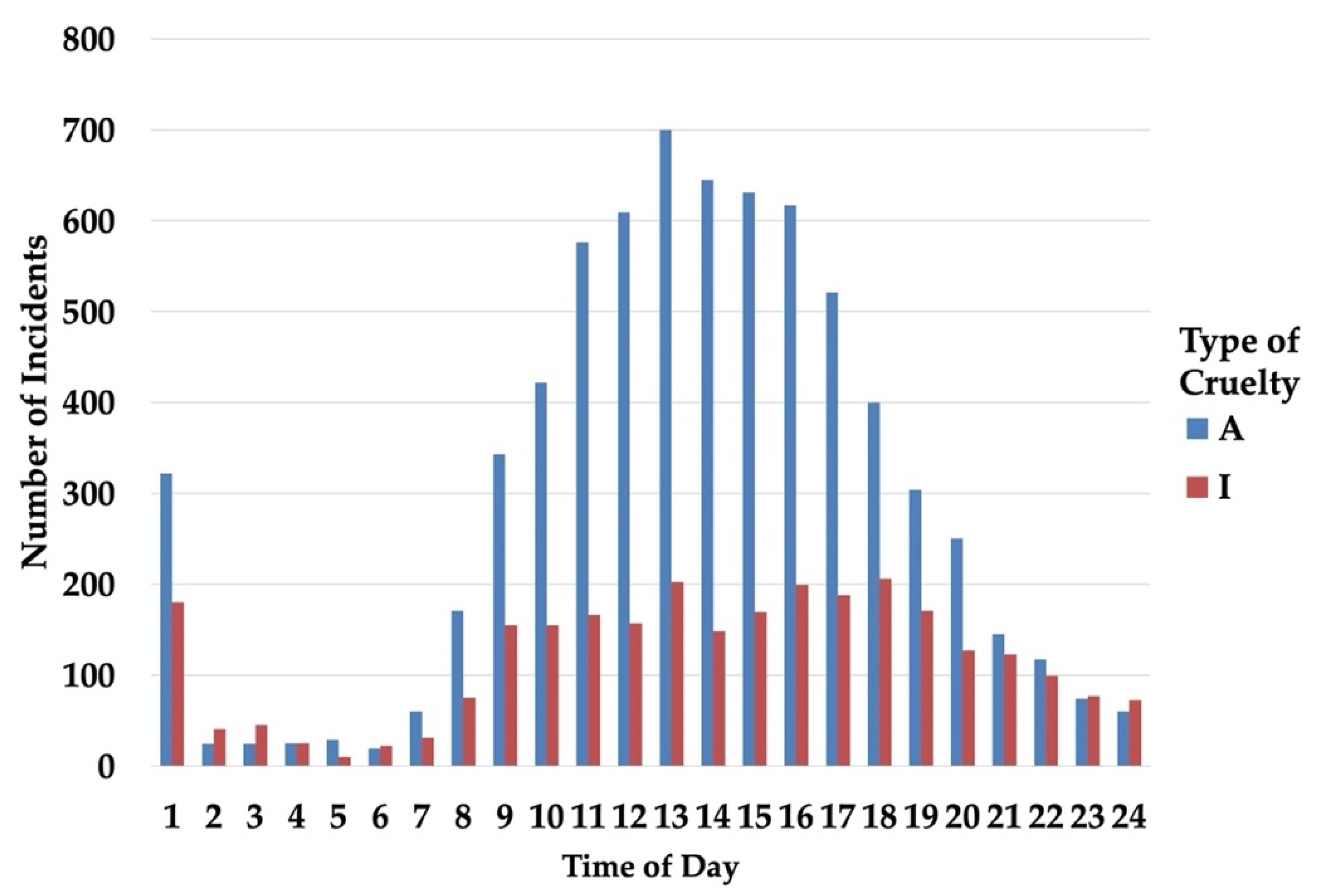


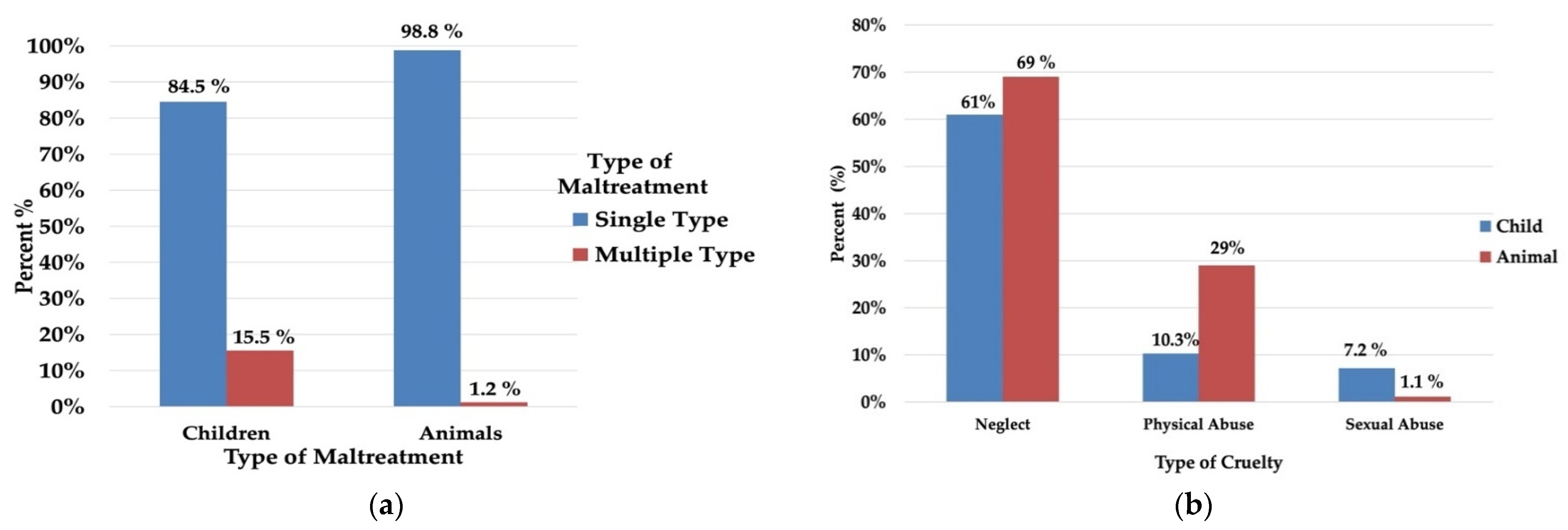
| NIBRS Data/Year | 2016 | 2017 | 2018 | 2019 |
|---|---|---|---|---|
| Number of Animal Cruelty Incidents | 1126 1 | 3228 1 | 5201 1 | 9956 1 |
| Number of agencies reporting NIBRS data | 6849 | 6998 | 7283 | 8497 |
| Number of agencies that reported animal cruelty data | n.a. | 722 (10%) 2 | 1056 (15%) 2 | 1721 (20%) 2 |
| State/Year | 2016 | 2017 | 2018 | 2019 |
| Alabama | 0 | 0 | 2 | 2 |
| Arizona | 0 | 0 | 2 | 43 |
| Arkansas | 0 | 0 | 0 | 6 |
| Colorado | 8 | 526 | 782 | 755 |
| Connecticut | 0 | 18 | 74 | 131 |
| Delaware | 494 | 923 | 1097 | 1294 |
| Georgia | 0 | 0 | 0 | 260 |
| Hawaii | 0 | 0 | 50 | 51 |
| Idaho | 0 | 2 | 7 | 34 |
| Illinois | 0 | 0 | 0 | 0 |
| Indiana | 0 | 0 | 0 | 311 |
| Iowa | 0 | 0 | 0 | 0 |
| Kansas | 0 | 0 | 0 | 0 |
| Kentucky | 0 | 45 | 186 | 266 |
| Louisiana | 0 | 0 | 0 | 0 |
| Maine | 0 | 3 | 13 | 8 |
| Maryland | 0 | 0 | 0 | 8 |
| State/Year | 2016 | 2017 | 2018 | 2019 |
| Massachusetts | 2 | 13 | 44 | 89 |
| Michigan | 130 | 277 | 398 | 520 |
| Minnesota | 1 | 4 | 61 | 272 |
| Mississippi | 0 | 0 | 47 | 193 |
| Missouri | 15 | 43 | 43 | 68 |
| Montana | 0 | 83 | 92 | 104 |
| Nebraska | 0 | 0 | 1 | 6 |
| Nevada | 0 | 0 | 0 | 1 |
| New Hampshire | 0 | 81 | 173 | 191 |
| New Mexico | 0 | 0 | 0 | 32 |
| North Carolina | 0 | 0 | 0 | 420 |
| North Dakota | 7 | 46 | 81 | 100 |
| Ohio | 0 | 23 | 102 | 164 |
| Oklahoma | 0 | 0 | 0 | 74 |
| Oregon | 105 | 134 | 421 | 446 |
| Pennsylvania | 0 | 0 | 0 | 0 |
| Rhode Island | 0 | 0 | 5 | 23 |
| South Carolina | 0 | 200 | 295 | 321 |
| South Dakota | 10 | 12 | 24 | 33 |
| Tennessee | 219 | 476 | 463 | 473 |
| Texas | 0 | 69 | 393 | 1394 |
| Utah | 0 | 0 | 0 | 6 |
| Vermont | 0 | 21 | 41 | 39 |
| Virginia | 0 | 0 | 0 | 1372 |
| Washington | 85 | 114 | 128 | 188 |
| West Virginia | 13 | 18 | 11 | 11 |
| Wisconsin | 37 | 97 | 154 | 237 |
| Wyoming | 0 | 0 | 0 | 10 |
Publisher’s Note: MDPI stays neutral with regard to jurisdictional claims in published maps and institutional affiliations. |
© 2021 by the author. Licensee MDPI, Basel, Switzerland. This article is an open access article distributed under the terms and conditions of the Creative Commons Attribution (CC BY) license (https://creativecommons.org/licenses/by/4.0/).
Share and Cite
Palais, J.M. Using the National Incident-Based Reporting System (NIBRS) to Study Animal Cruelty: Preliminary Results (2016–2019). Soc. Sci. 2021, 10, 378. https://doi.org/10.3390/socsci10100378
Palais JM. Using the National Incident-Based Reporting System (NIBRS) to Study Animal Cruelty: Preliminary Results (2016–2019). Social Sciences. 2021; 10(10):378. https://doi.org/10.3390/socsci10100378
Chicago/Turabian StylePalais, Julie M. 2021. "Using the National Incident-Based Reporting System (NIBRS) to Study Animal Cruelty: Preliminary Results (2016–2019)" Social Sciences 10, no. 10: 378. https://doi.org/10.3390/socsci10100378
APA StylePalais, J. M. (2021). Using the National Incident-Based Reporting System (NIBRS) to Study Animal Cruelty: Preliminary Results (2016–2019). Social Sciences, 10(10), 378. https://doi.org/10.3390/socsci10100378






